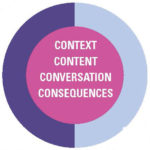
The introduction of new technology – from the earliest motion pictures to the latest smartphones – always raises concern among parents, educators, health professionals, policy makers and other adults about potentially harmful effects on our youth. Would too much attention to the latest technology exclude attention to important things like homework, chores, physical activity and face-to-face social interactions? Would there be harmful effects of exposure to the content, especially violence, sexually explicit material, or health-risking behaviors such as drug or alcohol use, disordered eating or self-injury? Often developed for entertainment and intended mainly for adults, technology is also used for education and marketing of goods, services and ideas with a target audience that includes children and adolescents in many instances.
Social media include social networks, blogs and text messaging. These interactive technologies have added new dimensions to these concerns. They allow youth (and adults) to communicate with almost anyone in the world and postings may be viewed by millions of people. Today’s teens say they have accounts with YouTube (85%), Instagram (72%), Snapchat (69%), Facebook (51%) and Twitter (32%). Many have accounts on more than one. Almost all have easy access to a smartphone, typically their own, which can be used to access their social media accounts in complete privacy and at any time. Close to half of teens admit to being online on a near constant basis.
Social media balancing – A fine line
Use of interactive social media has the potential for many positive benefits as well as risks and negative consequences. Here are some important ones to consider:
Communication: With social media, it’s easier to stay in touch with family members and friends wherever they may be and at any time. A broad circle of online friends can provide peer support during the struggles and stresses of adolescent development BUT communication may be intrusive or excessive and may interfere with sleep, schoolwork, driving or other important tasks. Also, excessive online communication may inhibit the development of face-to-face interpersonal skills critical to educational settings, the workplace and life in general.
Socialization: There are limitless opportunities to make new friends and have an expanded peer group. This can be especially supportive for youth facing challenges of chronic illnesses, disabling conditions or social isolation and limited access to transportation, BUT users may connect with peers who endorse and support negative behaviors such as excessive dieting, substance use or risky sexual behaviors. They may encounter cyberbullying by other youth (or even adults) who are unrestrained in being demeaning, rude or offensive in the relative anonymity of cyberspace. Cyberbullying is well known to have many negative consequences including poor self-image, depressed mood and changes in behavior.
Information seeking: Users can access the world wide web to help with homework or satisfy curiosity about anything imaginable. They can seek information and advice from anyone in their networks BUT they may intentionally or unintentionally access incorrect or incomplete information and experience unintended harmful consequences from following inappropriate advice. Young users may also lack the experience needed to distinguish true and genuine from false or exaggerated information.
Entertainment: Users can access any form of entertainment – movies, television programs, posted videos and blogs, video games, etc. – at any time BUT such ready access can lead to excessive distraction and less time for completion of homework or daily chores, adequate sleep or physical activity. Also concerning is that users may find or share videos or pictures that are age-inappropriate or risk promoting.
What can parents do?
In today’s digital world, children and youth need to learn and practice the use of all the technologies they will be using as adults, including interactive social media, BUT recent studies of adolescent brain development have shown that during early adolescence, the brain tends to focus most on new and exciting experiences and to favor immediate rewards over future benefits. Caution and consideration of consequences take longer to develop and this makes the teenage brain more susceptible to becoming addicted to things it considers “new and exciting” including nicotine, illegal drugs and electronic technology. Due to this gradual maturation of brain function, decision-making in early adolescence often is impulsive; while in later adolescence it is more thoughtful and less risky.
Consider these four “Cs” as you help guide your children in technology use. These can help ensure safe, responsible use of technology, achieve a healthy balance between screen time and other life activities, and promote an open and ongoing dialogue so that children and teens are comfortable seeking your guidance when they encounter anything questionable or upsetting online, including disturbing messages or images.
Context: Be aware of when, where and how your children are using their technology and social media. Consider the role-modeling of your own use of social networking, video gaming, texting when driving, taking and sharing of pictures, and focusing on screens instead of family members.
 Content: Be aware of what your children are accessing on social media. Who are their online friends? Are they age-appropriate? Do they seem to share your own values for healthy behaviors? What sites are visited and do they present harmful advice or misinformation?
Content: Be aware of what your children are accessing on social media. Who are their online friends? Are they age-appropriate? Do they seem to share your own values for healthy behaviors? What sites are visited and do they present harmful advice or misinformation?
Conversation: Maintain regular communication with your children about their use of technology, especially social media. Ask to have your child’s passwords and usernames and check in occasionally, while respecting their privacy. Ask about and share your concerns about any inappropriate or potentially harmful content or communications. Teach internet safety and educate about digital citizenship, persuasion awareness (marketers trying to sell to youth) and practices such as sexting which may bring unwanted legal consequences.
Consequences: Set limits on time spent on technology based on age and other needs such as homework, chores, time with family and bedtime. Apply limits to adults in the family as well. Consider developing a contract with your child that sets rules of conduct for using the technologies and defines consequences for violation of rules. An excellent model contract can be found.on Janell Burley Hofmann’s iRules website and in her book, iRules: What Every Tech-Healthy Family Needs to Know about Selfies, Sexting, Gaming and Growing Up. (Both are listed below.) The American Academy of Pediatrics website (also listed below) provides guidelines for creating a Family Media Use Plan in their Media and Children Communication Toolkit.
Websites and books with more on this important topic:
- American Academy of Pediatrics Media and Children Communication ToolKit
- Common Sense Media
- iRules: janellburleyhofmann.com/irules/
- iRules: What Every Tech-Healthy Family Needs to Know About Selfies, Sexting, Gaming, and Growing Up by Janell Burley Hofmann
- It’s Complicated: The Social Lives of Networked Teens by Danah Boyd
- Screenwise: Helping Kids Thrive (and Survive) in Their Digital World by Devorah Heitner
- Social Media Wellness: Helping Tweens and Teens Thrive in an Unbalanced Digital World by Ana Homayoun
- The Art of Screen Time: How Your Family Can Balance Digital Media and Real Life by Anya Kamenetz
Dr. Richard Brookman, adolescent medicine specialist
Adolescent medicine includes doctors with special training in caring for individuals ages 12 to 22. Our adolescent medicine team provides care for medical and behavioral problems, minor injuries, sexual concerns, skin problems and other needs associated with adolescence. Annual exams, physicals, immunizations and same/next-day urgent appointments are available.
